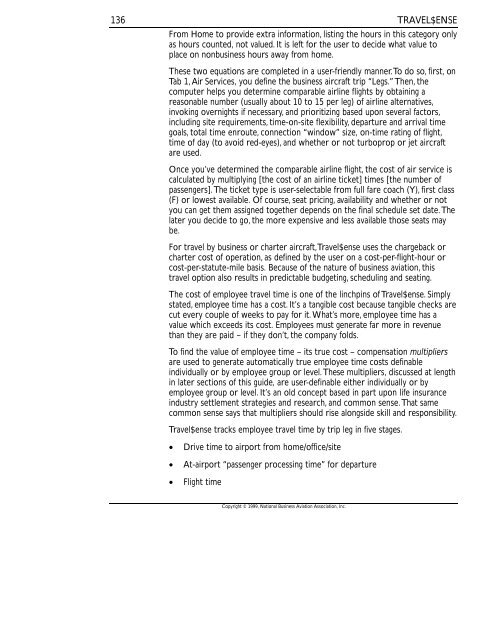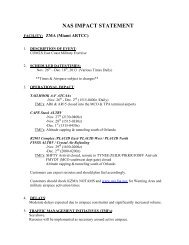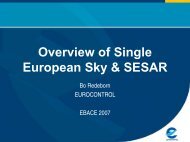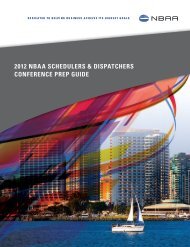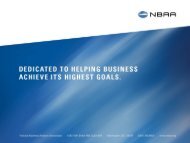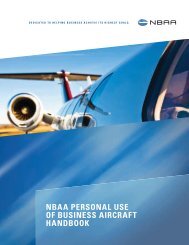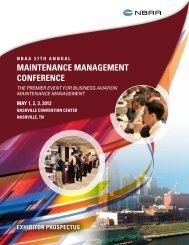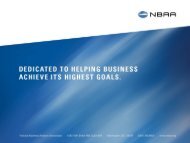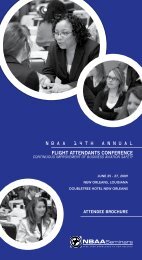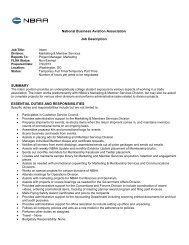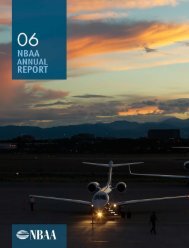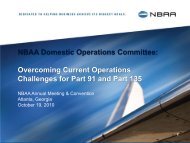Travel$ense User's Guide (PDF, 139 MB) - NBAA
Travel$ense User's Guide (PDF, 139 MB) - NBAA
Travel$ense User's Guide (PDF, 139 MB) - NBAA
- No tags were found...
Create successful ePaper yourself
Turn your PDF publications into a flip-book with our unique Google optimized e-Paper software.
136TRAVEL$ENSEFrom Home to provide extra information, listing the hours in this category onlyas hours counted, not valued. It is left for the user to decide what value toplace on nonbusiness hours away from home.These two equations are completed in a user-friendly manner. To do so, first, onTab 1, Air Services, you define the business aircraft trip “Legs.” Then, thecomputer helps you determine comparable airline flights by obtaining areasonable number (usually about 10 to 15 per leg) of airline alternatives,invoking overnights if necessary, and prioritizing based upon several factors,including site requirements, time-on-site flexibility, departure and arrival timegoals, total time enroute, connection “window” size, on-time rating of flight,time of day (to avoid red-eyes), and whether or not turboprop or jet aircraftare used.Once you’ve determined the comparable airline flight, the cost of air service iscalculated by multiplying [the cost of an airline ticket] times [the number ofpassengers]. The ticket type is user-selectable from full fare coach (Y), first class(F) or lowest available. Of course, seat pricing, availability and whether or notyou can get them assigned together depends on the final schedule set date. Thelater you decide to go, the more expensive and less available those seats maybe.For travel by business or charter aircraft, <strong>Travel$ense</strong> uses the chargeback orcharter cost of operation, as defined by the user on a cost-per-flight-hour orcost-per-statute-mile basis. Because of the nature of business aviation, thistravel option also results in predictable budgeting, scheduling and seating.The cost of employee travel time is one of the linchpins of <strong>Travel$ense</strong>. Simplystated, employee time has a cost. It’s a tangible cost because tangible checks arecut every couple of weeks to pay for it. What’s more, employee time has avalue which exceeds its cost. Employees must generate far more in revenuethan they are paid – if they don’t, the company folds.To find the value of employee time – its true cost – compensation multipliersare used to generate automatically true employee time costs definableindividually or by employee group or level. These multipliers, discussed at lengthin later sections of this guide, are user-definable either individually or byemployee group or level. It’s an old concept based in part upon life insuranceindustry settlement strategies and research, and common sense. That samecommon sense says that multipliers should rise alongside skill and responsibility.<strong>Travel$ense</strong> tracks employee travel time by trip leg in five stages.• Drive time to airport from home/office/site• At-airport “passenger processing time” for departure• Flight timeCopyright © 1999, National Business Aviation Association, Inc.


